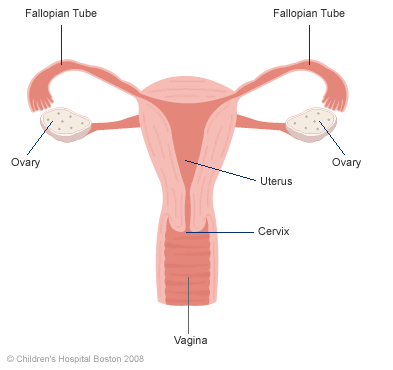Birth Control: Female Barrier Methods
 What does the term “barrier method” mean?
What does the term “barrier method” mean?
A “barrier” is something that blocks or separates; for example, a wall or a fence. The term “female barrier method” of birth control means that there is a barrier (either physical or chemical) that is used to prevent a man’s sperm from reaching a female’s egg and thus preventing pregnancy.
What does the female reproductive system look like?
Take a look at the image below to become familiar with the female reproductive system.

What are the different types of female barrier methods?
There are five types of female barrier methods:
How does each method work, and how effective are they at preventing pregnancy?
Each female barrier method has a different efficacy rate towards preventing pregnancy. These rates vary depending on “typical use” (how people usually use it or if it’s not used every time you have sex) vs. “perfect use” (when it’s used perfectly, every time you have sex). Keep in mind that perfect use hardly ever happens.
Spermicides
Spermicides are a chemical barrier method of birth control that come in different forms, such as foams, creams, jellies, suppositories (small oval shaped devices that get placed in the vagina and release a foam), and films (small paper-like tissues that get inserted into the vagina). They work to prevent pregnancy by paralyzing or killing sperm so that the sperm can’t pass through a woman’s cervix and reach her uterus.
| Out of 100 women using spermicides | |
| Typical use: 28 women become pregnant in a year |                             |
| Perfect use: 18 women become pregnant in a year |                   |
Cervical Cap:
A cervical cap is a small dome-shaped cup that fits tightly around the base of a woman’s cervix (the opening of the uterus at the top of the vagina). The cap forms a physical barrier to stop sperm from reaching a woman’s uterus. The FemCap is the only brand of cervical cap that is currently available in Europe, Canada, and the United States. Note: Spermicide always needs to be used with the cervical cap.
To understand how effective the cervical cap is, first you need to know that there are two different sets of efficacy rates. One set is called “nulliparous” and another called “parous.” Nulliparous is a medical term that means a woman has never given birth to a baby. Parous is a medical term that means that a woman has given birth to one or more babies.
| Out of 100 nulliparous women using a cervical cap | |
| Typical use: 14 women become pregnant in a year |               |
| Perfect use: 9 women become pregnant in a year |          |
| Out of 100 parous women using a cervical cap | |
| Typical use: 29 women become pregnant in a year |                              |
| Perfect use: 26 women become pregnant in a year |                           |
Contraceptive Sponge:
The contraceptive sponge is a small, doughnut-shaped foam sponge that contains spermicide. It’s placed in a woman’s vagina, and a “dimple” on one side fits over the cervix and stops sperm from reaching the uterus. Once in the vagina, the sponge releases spermicide.
Like the cervical cap, the contraceptive sponge has two different sets of efficacy rates; one for “nulliparous” women and one for “parous” women.
| Out of 100 nulliparous women using a contraceptive sponge | |
| Typical use: 12 women become pregnant in a year |             |
| Perfect use: 9 women become pregnant in a year |          |
| Out of 100 parous women using a contraceptive sponge | |
| Typical use: 24 women become pregnant in a year |                         |
| Perfect use: 20 women become pregnant in a year |                     |
Diaphragm:
A diaphragm is another small dome-shaped device that fits inside the vagina and covers the cervix. To obtain a diaphragm, a woman will need to be fitted for one by her health care provider, and she will also need a prescription. Note: Spermicide always needs to be used with a diaphragm.
| Out of 100 women using a diaphragm with spermicide | |
| Typical use: 12 women become pregnant in a year |             |
| Perfect use: 6 women become pregnant in a year |       |
Female Condom:
The female condom is a thin, lubricated sheath (with two ends) that gets placed inside the vagina. One end has a closed ring that lies inside the vagina and covers the cervix, forming a barrier. The other end has a ring which lies outside the vagina. This ring is open, allowing for intercourse. Note: Never use a male condom and a female condom at the same time.
| Out of 100 women using a female condom | |
| Typical use: 21 women become pregnant in a year |                      |
| Perfect use: 5 women become pregnant in a year |      |
Do female barrier methods protect against STIs?
For the most part, no. The cervical cap, contraceptive sponge, diaphragm, and spermicide do NOT protect against STIs. The ONLY female barrier method that protects against STIs is the female condom.
Source: Read Full Article



